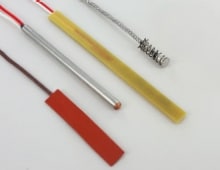Resistance Temperature Detector
RTD sensors are used to measure temperature by changing resistance proportional to the temperature. RTD's are designed with basic temperature elements as well as fully packaged assemblies. These so called RTD probes consist of a RTD sensor element, a sheath or housing, an epoxy or filler, extension leads and sometimes a connector or termination. Various sensor materials are available based on customer requirements for material compatibility, accuracy, and measurement range. Standard packages as well as custom designs allow for the flexibility to design the most suitable RTD temperature sensors for a variety of applications.
While an NTC thermistor is also a resistance device, an RTD is reserved for positive temperature coefficient metal resistance detectors. Typically, RTDs are manufactured with base metals such as platinum, nickel, or copper as these materials have a positive temperature coefficient that is very linear and repeatable. Typical operating temperature range is from -50°C to +600°C but special designs allow usage from -200°C to +1000°C.
We manufacture RTD probes and assemblies, and RTD sensor elements, both platinum thin film as well as glass wire-wound. Platinum (Pt) is the most common material used for RTDs as it has the most stable resistance–temperature relationship over the largest temperature range. To provide interchangeability between manufacturers for the sake of global industry, there are some international standards that have been adopted by most countries including DIN EN 60751 which defines the temperature accuracy and the resistance/temperature characteristic curve for several tolerance classes.
Our RTD platinum thin film elements provide high accuracy and stability, with a wide selection of standard sizes, accuracy classes and are available in both Pt100 and Pt1000 base resistance values to meet the growing industry demand for accurate, stable and reliable platinum sensor elements.
Applications
The applications for RTD sensors are extremely broad, including medical, aerospace, automotive, instrumentation, appliances, motor control and HVACR. These temperature sensors can operate on board level components as well as in harsh and hazardous locations with various agency approvals. One expanding application for platinum sensor assemblies is for exhaust gas temperature (EGT) measurement. An EGT sensor measures the temperature of the engine exhaust gas to prevent damage to critical components such as the after-treatment system, turbines and cylinder head exhaust valves. An EGT can help optimize engine performance and deliver savings in fuel and maintenance costs.


